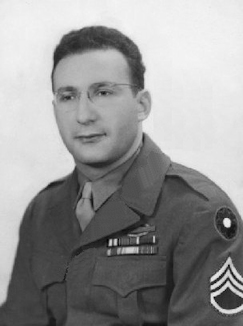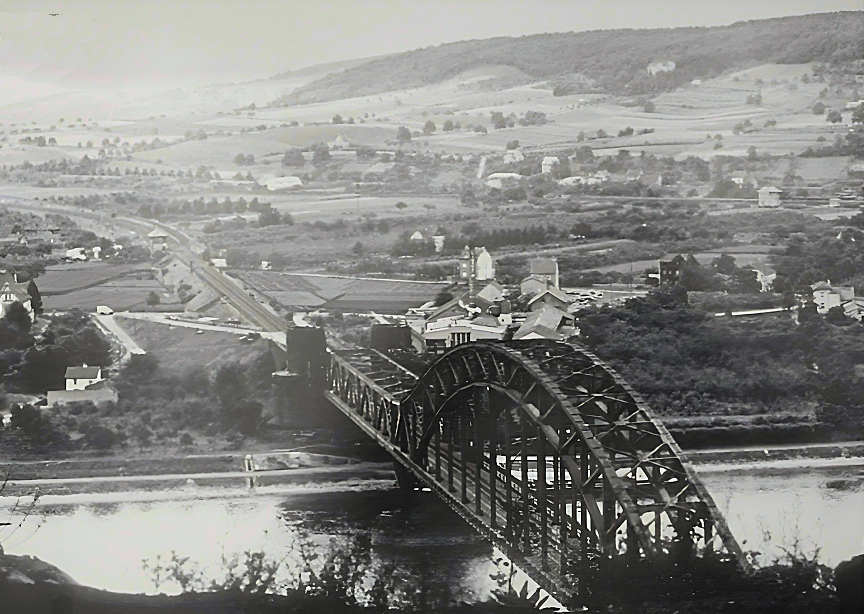
9th Infantry Division
Co. L - 39th Infantry Regiment

Excerpted from MY FRIEND IS A HERO by Norman L Bloom
published in REPORTER - March, April, May, June, July 2009
September 2, 1944
Liberation of Belgium began. We were running out of fuel but we reached the village of Eppe Sauvage and next went into Belgium. Passed thru Momignies and pushed toward Charleroi. Slowed by mines and small arms fire. We were rerouted to Dinant as Intelligence reported the Germans planned to effect strong delay action along the Sambre River and Meuse River line.
September 4, 1944
We were to march on Meuse, but could not cross during the day as there was heavy fire from tanks, artillery, mortars and small boats. All of the bridges had been blown up and destroyed. A midnight crossing by small boats was planned. Went using dinghies and we were spotted. Just sitting ducks for the Germans. Some of us made it, and others didn't.
September 5, 1944
The Engineers tried to build pontoons but German fire prevented it and they had heavy casualties. Finally, with skills learned from experiences in the North Africa and Sicily fighting, we got over the river, dug in, and formed a defensive perimeter. We had successfully crossed the river and were building a position. We were certainly no longer green troops. We knew most of the tricks of our enemy and we knew how to find solutions to most of the problems we encountered. We knew what we had to do when attacking enemy positions and we did it well. Our experience served us well even on the frontline.
September 6, 1944
Larger groups of Germans had withdrawn and by morning, only rear guard troops were evident. Dinant was taken and we were in control of the town. The Germans were retreating to the Siegfried Line and left behind equipment, guns and trucks. Our Artillery played havoc on their retreat.
October 12, 1944
Columbus Day. More heavy casualties as German resistance is heavy on our advance toward Vossenack. Brigadier Gen. Marshall, Army Chief of Staff, visited the 9th Division today. We were attacking to hold our advance on the Roer River Dams and there were heavy counter attacks all day.
October 13, 1944
We counter attack again and retake the positions the Germans had occupied.
Herb was awarded the rare Silver Star for his heroics this day and again he did not feel that the action that day was worth recording in his dairy. On one important mission, he was attempting to cross a field of fire and his radio was shot right off his back. He finished the mission despite continuing attempts by German riflemen to pick him off. The medal reads that "his aggressiveness, initiative and devotion to duty, with complete disregard for personal safety were a credit to the Armed Forces of the United States." He continues to proudly wear the Silver Star on his lapel to this day.
October 15, 1944
Showers were arranged: First time after many weeks in the same clothes. They had captured a German trailer that had four showers and a dressing room.
October 16, 1944
We joined the Huertgen Forest campaign which had been raging for some time. We were in a defensive position laying mines, sending out patrols.. We were under artillery mortar and small arms fire continually from the well dug in Germans who were determined to hold. Casualties were extremely heavy and I witnessed trucks carrying the dead with the bodies stacked up like so much firewood. Beats me why the Army did not choose to simply bypass this forest and leave the Germans stranded there while we continued our march behind them.
November 8, 1944
General Eisenhower and General Bradley visited the 9th's Company Post.
November 16, 1944
Largest air strike of the War. Weather had been bad but when the heavens opened up, 5,000 planes dumped 20 million pounds of Arial Bombs on four key German cities, plus we added artillery and mortar fire. Dueren and Juelich were obliterated and other towns leveled. We cleaned up in house-to-house fighting.
December 16, 1944
Today, so far, it has been unusually quiet. (What was later called The Battle of the Bulge begins.) The Germans sent tanks, artillery and planes south of Monschau in a counter offensive. More Germans went on a blitz to Antwerp to try to cut off the 1st Division U.S. and the British from the allies to the south, and to seize their only supply port. The major German force was designed to hit us between Monschau and Echternach, and to recapture Antwerp. We had only four divisions holding this 75 mile front. The Germans had massed 14 infantry divisions, 10 SS Panzer Divisions, and also some English speaking German troops. They parachuted behind American Lines to do sabotage, cut roadways, cause confusion. and seize vital supplies in dump area.
December 22, 1944
Germans were infiltrating our positions, counter attacking in the Rohrer area. We held them off with mass artillery fire from the 9th , 2nd, and 99th and inflicted heavy casualties.
December 23, 1944
We attacked and regained the area we had lost the night before in some of the toughest fighting I had seen so far. We were told that 11,000 rounds of ammo were fired in one location -Hohe Mark- during the night of December 22.
January 2, 1945
Many problems with supplies due to deep snow and freezing temperatures. We were issued felt inner soles and camouflage snowsuits, and charcoal was issued for use in improvised stoves. Raw wool found in a local felt manufacturing plant, was issued to line our foxholes. Our company with three tanks in support, jumped off to push the Germans out of the Schwalmbach area. Resistance was stubborn.
January 15, 1945
We were successful in sealing off the Germans within the Bulge. We heard that Von Rundstadt gave the German troops orders to withdraw. This entire month, during what was called the "Bulge," has been cold, snowy and with very limited visibility. We suffered thru blizzards, trench feet, frostbite and German artillery.
February 2, 1945
Captured Forsthaus and Wahlerscheid, which had strong German style defenses, including three room bunkers, walls 40" thick and roofs 45 inches thick. The pillboxes were camouflaged and protected by barbed wire, trenches, and foxholes.
February 3, 1945
The offence is a week old. Drifting snow added little to the dreary and desolate fields around Dreiborn. At Dreiborn Castle, we waded thru icy slush to reach the enemy. Artillery support was impossible so it was up to the riflemen fire and hand grenades for support. We passed thru Dreiborn and reached the vicinity of Herhahn and dug in.
February 4, 1945
Our objective was to seize the Urfttalsperre Dam the second largest of five. It contained 12 million gallons of water. G-2 said that if the Germans lost it, it was "Goodbye Charlie." We were again the spearhead as we relieved the 60th Infantry on the line. The Germans began counter attacks as we were passing thru the 3rd Battalion of the 60th, and we were peppered with small arms machine gun fire. At about two A.M. four or five German tanks began firing on us. Then two self-propelled guns approached and we were under more direct fire. The 9th Division and 2nd Division artillery, plus our own Corp's artillery all helped us to repulse the German counter attack. We pitched in with Bazooka and anti-tank at dawn. We pushed into Morsbach, where we chased the Germans out of town. We took positions on the high ground and fired everything in the book at the retreating Germans. It was like a shooting gallery, while they tried their best to withdraw over the river.
March 7, 1945
 Ludendorff Bridge at Remagen, view from Erpel towards Remagen
Ludendorff Bridge at Remagen, view from Erpel towards RemagenAll of the bridges over the Rhine were blown up except for one -Ludendorff Bridge- below the town of Remagen. This bridge was wired for demolition but was not blown. The bridge was crossed by the 9th Armored. On hearing the news, the rest of the 9th Division changed its direction of attack, rushed to the Remagen bridge and crossed it.
This day, ten days later, the weakened bridge at Remagen finally did collapse. We were across the river today and advancing against heavy resistance.
March 18, 1945
While advancing on the attack, I was under a tree and tank fire hit the tree. There were six of us around the tree and shrapnel from the shell hit my right leg at the ankle and wounded use severely. It also killed three of my buddies and wounded two others beside me. The action was too hot for anyone to come and help us, so I crawled about two hundred yards back and found the Aid Station. They put me on a stretcher and said I would be treated soon. After treating the more severely wounded, they attended to my leg. I was evacuated and flown to Orly Field in Paris to a hospital there. What a difference it was to me. After three years in the fields, finally an atmosphere of tranquility and no sign of the war other than the wounded at the hospital. I stayed in the hospital until May 18, 1945 , the end of the end of the War in Europe.
NOTE FROM HERB TAFF. The diary you are reading, served to help me keep my sanity during that long period of extreme danger to which I was exposed. When I look back on my notes, I am amazed that I even survived. It was as grim as I recorded it and worse. I realize that I am the only living link to so many of my buddies who perished in that war. They only exist now in my memories which I am sure will haunt me for the rest of my life.
In memory of Herb Taff
July 26, 1919 - † July 20, 2014.

Source: Reporter June 2009 Volume 32 Number 9
